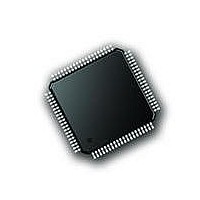PIC18F87J72-I/PT Microchip Technology, PIC18F87J72-I/PT Datasheet - Page 80

PIC18F87J72-I/PT
Manufacturer Part Number
PIC18F87J72-I/PT
Description
IC PIC MCU 8BIT 14KB FLSH 80TQFP
Manufacturer
Microchip Technology
Series
PIC® 18Fr
Datasheet
1.PIC18F86J72-IPT.pdf
(480 pages)
Specifications of PIC18F87J72-I/PT
Program Memory Type
FLASH
Program Memory Size
128KB (64K x 16)
Package / Case
80-TQFP
Core Processor
PIC
Core Size
8-Bit
Speed
48MHz
Connectivity
I²C, LIN, SPI, UART/USART
Peripherals
Brown-out Detect/Reset, LCD, LVD, POR, PWM, WDT
Number Of I /o
51
Ram Size
3.8K x 8
Voltage - Supply (vcc/vdd)
2 V ~ 3.6 V
Data Converters
A/D 12x12b
Oscillator Type
Internal
Operating Temperature
-40°C ~ 85°C
Data Bus Width
8 bit
Data Ram Size
4 KB
Interface Type
SPI, USART, SPI, I2C
Maximum Clock Frequency
8 MHz
Number Of Programmable I/os
51
Number Of Timers
4
Operating Supply Voltage
2 V to 3.6 V
Maximum Operating Temperature
+ 85 C
Mounting Style
SMD/SMT
Minimum Operating Temperature
- 40 C
On-chip Adc
14
Controller Family/series
PIC18F
No. Of I/o's
51
Ram Memory Size
3923Byte
Cpu Speed
48MHz
No. Of Timers
4
Rohs Compliant
Yes
Lead Free Status / RoHS Status
Lead free / RoHS Compliant
Lead Free Status / RoHS Status
Lead free / RoHS Compliant, Lead free / RoHS Compliant
Available stocks
Company
Part Number
Manufacturer
Quantity
Price
Company:
Part Number:
PIC18F87J72-I/PT
Manufacturer:
Microchip
Quantity:
210
Company:
Part Number:
PIC18F87J72-I/PT
Manufacturer:
Microchip Technology
Quantity:
10 000
- Current page: 80 of 480
- Download datasheet (5Mb)
PIC18F87J72 FAMILY
7.2.2
The Table Latch (TABLAT) is an 8-bit register mapped
into the SFR space. The Table Latch register is used to
hold 8-bit data during data transfers between program
memory and data RAM.
7.2.3
The Table Pointer (TBLPTR) register addresses a byte
within the program memory. The TBLPTR is comprised
of three SFR registers: Table Pointer Upper Byte, Table
Pointer High Byte and Table Pointer Low Byte
(TBLPTRU:TBLPTRH:TBLPTRL). These three regis-
ters join to form a 22-bit wide pointer. The low-order
21 bits allow the device to address up to 2 Mbytes of
program memory space. The 22nd bit allows access to
the device ID, the user ID and the Configuration bits.
The Table Pointer register, TBLPTR, is used by the
TBLRD and TBLWT instructions. These instructions can
update the TBLPTR in one of four ways based on the
table operation. These operations are shown in
Table 7-1. These operations on the TBLPTR only affect
the low-order 21 bits.
TABLE 7-1:
FIGURE 7-3:
DS39979A-page 80
TBLRD*
TBLWT*
TBLRD*+
TBLWT*+
TBLRD*-
TBLWT*-
TBLRD+*
TBLWT+*
Example
21
TABLE LATCH REGISTER (TABLAT)
TABLE POINTER REGISTER
(TBLPTR)
TABLE POINTER OPERATIONS WITH TBLRD AND TBLWT INSTRUCTIONS
TBLPTRU
TABLE POINTER BOUNDARIES BASED ON OPERATION
ERASE: TBLPTR<20:10>
16
15
TABLE WRITE: TBLPTR<20:6>
TBLPTR is incremented before the read/write
TBLPTR is decremented after the read/write
TBLPTR is incremented after the read/write
TABLE READ: TBLPTR<21:0>
TBLPTRH
Preliminary
Operation on Table Pointer
TBLPTR is not modified
7.2.4
TBLPTR is used in reads, writes and erases of the
Flash program memory.
When a TBLRD is executed, all 22 bits of the TBLPTR
determine which byte is read from program memory
into TABLAT.
When a TBLWT is executed, the seven LSbs of the
Table Pointer register (TBLPTR<6:0>) determine which
of the 64 program memory holding registers is written
to. When the timed write to program memory begins
(via the WR bit), the 12 MSbs of the TBLPTR
(TBLPTR<21:10>) determine which program memory
block of 1,024 bytes is written to. For more detail, see
Section 7.5 “Writing to Flash Program Memory”.
When an erase of program memory is executed, the
12 MSbs of the Table Pointer register point to the
1,024-byte block that will be erased. The Least
Significant bits are ignored.
Figure 7-3 describes the relevant boundaries of
TBLPTR based on Flash program memory operations.
8
7
TABLE POINTER BOUNDARIES
TBLPTRL
2010 Microchip Technology Inc.
0
Related parts for PIC18F87J72-I/PT
Image
Part Number
Description
Manufacturer
Datasheet
Request
R

Part Number:
Description:
Manufacturer:
Microchip Technology Inc.
Datasheet:

Part Number:
Description:
Manufacturer:
Microchip Technology Inc.
Datasheet:

Part Number:
Description:
Manufacturer:
Microchip Technology Inc.
Datasheet:

Part Number:
Description:
Manufacturer:
Microchip Technology Inc.
Datasheet:

Part Number:
Description:
Manufacturer:
Microchip Technology Inc.
Datasheet:

Part Number:
Description:
Manufacturer:
Microchip Technology Inc.
Datasheet:

Part Number:
Description:
Manufacturer:
Microchip Technology Inc.
Datasheet:

Part Number:
Description:
Manufacturer:
Microchip Technology Inc.
Datasheet:











